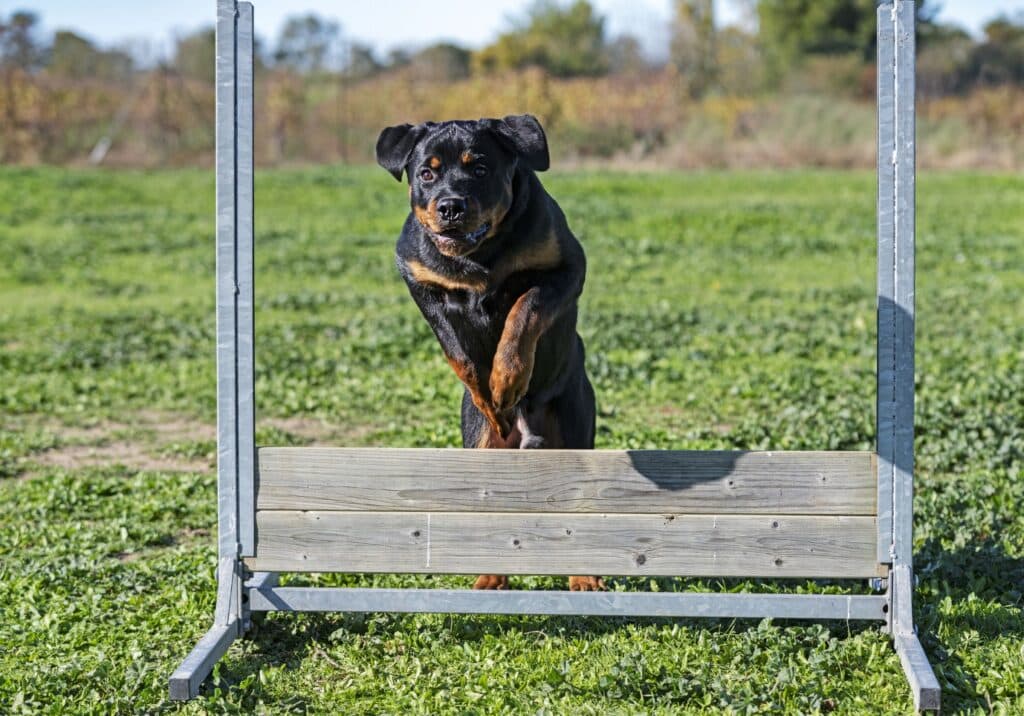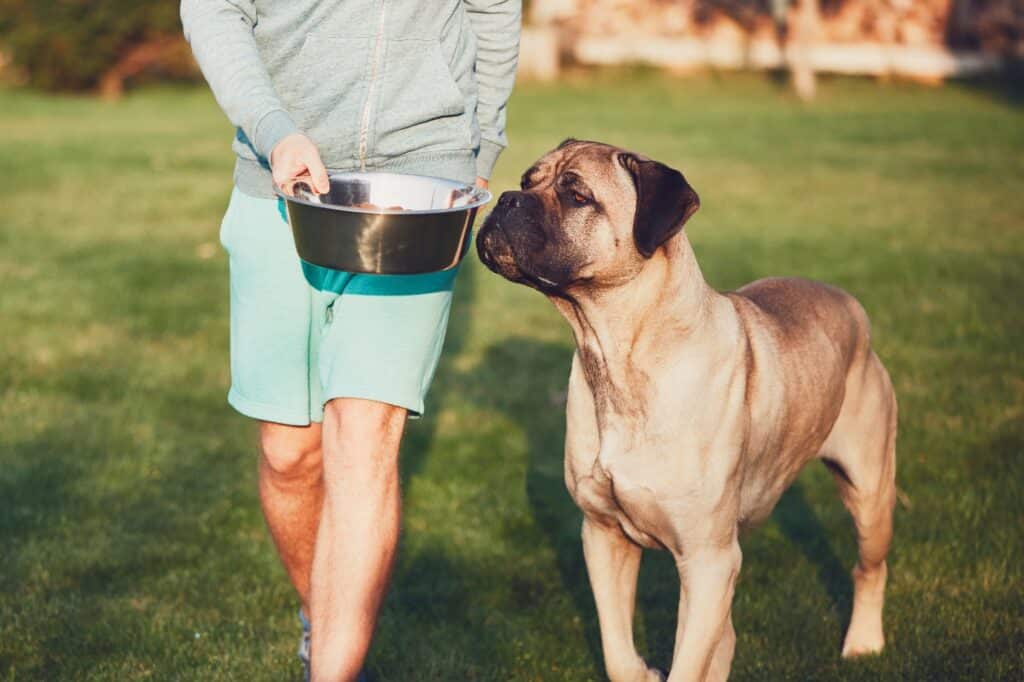Looking for information on the Cane Corso Rottweiler mix? In this guide, we will discuss everything you need to know about the Rotticorso.
We’ll talk about their temperament, training, exercise, grooming, and health conditions, and what to expect if you decide to adopt one of these dogs.
Cane Corso Rottweiler Mix – Background
The Cane Corso Rottweiler mix combines traits from both the Cane Corso and the Rottweiler.
Going back in history, we can see some major differences between the parent breeds.
While the Cane Corso was developed mainly for hunting purposes, the Rottweiler is a German breed that was mainly used for pulling carts and herding livestock.
“When combing these breeds, owners can expect the muscular build of the Rottweiler combined with the sleek coat of the Cane Corso.”
Other than their physical appearance, there is so much more to learn about this breed before choosing to adopt.
Read on further as we take a look at their other traits and behaviors to be aware of, along with their temperament, training, and exercise needs.
We’ll also look at the maintenance requirements and certain health issues you should be aware of. Let’s get started!
You may also like – Discover the Rottweiler English Bulldog Mix
Rotticorso – Appearance
Also known as the Rotticorso, this mixed breed is massive in size, weighing anywhere between 80 to 120 pounds and standing 22 to 27 inches tall.
They have a large, blocky head, with a short, broad muzzle and floppy ears. Their eyes are typically dark and almond-shaped in appearance.
Along with their size, they are quite muscular and athletic and will generally have well-defined legs and a long, thick tail.
Their coat is short and dense and can be either black, blue, gray, fawn, brindle, or any combination of these colors with white markings.
Rotticorso – Temperament
The Rotticorso is naturally quite protective and is known to be devoted and loyal to their families.
This can lead to suspicious and sometimes aggressive behavior towards strangers, especially if they are not properly socialized.
Early training and socialization are therefore crucial to ensure the Rotticorso grows up to be a well-rounded and even-tempered dog.
Rotticorso – Training Needs
Due to the sheer size and high energy of this breed, early obedience training is going to be a key requirement.
This is further compounded by their protective instincts which need to be tempered to avoid any unnecessary aggression.
The Rotticorso will typically respond well to structured training involving positive reinforcement. This could include treats, praise, or affection.
They are not fond of any negative reinforcement at all. In fact, punishing them this way is likely to create anxiety and prolong their negative behavior.
Rotticorso – Are they Aggressive?
If the Rotticorso is trained from an early age and socialized with other dogs and people, it will likely develop a stable and even temperament.
Many people assume that all large dogs are aggressive; this is not true.
This breed responds well to training from its owners, and this can make a huge difference in their overall temperament and behavior in most situations.
Keeping in mind that both the Rottweiler and Cane Corso parents are known to be very protective and energetic.
This can often lead to the offspring becoming territorial and unsociable with others if not properly trained.
While these behaviors are not always present, they cannot be ruled out and owners should expect this breed to show some aggression at times.
Rotticorso – Exercise Needs

This breed has medium to high energy levels and requires regular daily exercise.
This is no surprise, considering both parent breeds and known to be lively and energetic.
Rotticorsos typically need 1 hour of solid exercise daily. A simple walk isn’t going to cut it. They need some running and opportunities to release any pent-up energy developed over the course of the day.
There are many options available to keep this breed active and occupied. Frisbee, chasing tennis balls, or running on the beach or at the park are great options.
Rotticorso – Mental Stimulation
Along with physical exercise, the Rotticorso also needs regular mental stimulation as well.
As they are quite lively and intelligent, mental exercises will be important to keep any boredom at bay. We all know what happens when our dogs become bored. They will start doing silly things, digging, chewing, the list goes on!
Fortunately, there are many ways to keep this breed mentally stimulated.
“One way is to provide them with a variety of toys that they can rotate through so they don’t get bored.“
You can also enroll them in dog sports or activities such as agility, tracking, or nose work.
Including brain exercises and activities with physical exercise will go a long way in helping even out their temperaments.
Rotticorso – Grooming Needs
While this breed is considered fairly low maintenance, certain things need to be taken care of to keep them looking and feeling healthy.
As they have a short, dense coat, weekly brushing is required to remove any built-up dirt. Two to three times each week should be enough.
“The Rotticorso is also an average shedder. So regular vacuuming will be required, especially during shedding seasons in the spring and fall.”
Depending on the surfaces they run on, their nails may need to be trimmed regularly. And finally, their ears should also be checked every week or two. This is required to ensure there are no ear infections that sometimes develop.
Rotticorso – Health Conditions
The Rotticorso has its fair share of health problems that owners need to be aware of. When considering the health issues experienced by both parent breeds, it’s no surprise that their offspring will inherit some health concerns as well.
The main conditions to be aware of are hip dysplasia and elbow dysplasia, which are both degenerative conditions affecting the hip and elbow joints.
It’s no surprise that these are both common in the Rottweiler parent.
These can be extremely painful for this breed, however, can be treated and managed with ongoing medication.
The Rotticorso is also at risk for developing certain types of cancer, including osteosarcoma (bone cancer) and lymphoma.
Owners of this breed should stay up to date with their dog’s health and vaccination requirements and seek prompt medical attention if any problems arise.
Rotticorso – What should they Eat?

It should be no surprise that the Rotticorso has a large appetite!
With their muscular athletic build and boundless energy, they need a healthy, well-balanced diet to ensure their daily needs are met.
Rotticorso puppies should be fed three to four times per day, while adult dogs can be fed twice a day.
This includes high-quality dog food that is specifically formulated for large breeds.
“Keep in mind that this breed is also prone to weight gain, so it’s important to avoid giving them table scraps or extra snacks between meals.”
Instead, focus on providing them with a diet that is high in protein and low in calories.
It’s also best to avoid brands that use fillers or artificial ingredients, as these can cause health problems down the road.
Rotticorso – Are they Dog Friendly?
Due to this breed’s protective instincts and dominant nature, they will likely have issues with other dogs if not properly socialized.
They can become rather territorial, which can be an issue when other dogs are around.
Rotticorso owners will therefore need to introduce their dogs to other breeds from an early age. This will help develop their social skills and reduce the likelihood of territorial aggression.
Rotticorso – Are they Child Friendly?

Due to this breed’s protective instincts, they are typically friendly toward children in the family home. This stems from their loyal nature and willingness to protect their owners at all costs.
Problems can arise however when small children are around. The size and energy levels of the Rotticorso can be dangerous and cause accidents with young children, especially if they’re not supervised.
Rotticorso – Do they Drool?
The Rotticorso is known as a low to moderate drooler, and will only slobber on certain occasions.
This will usually occur after they have eaten their meals, or when they get excited at the prospect of playtime or being given a snack.
Rotticorso – Barking Levels
The Rotticorso has a loud distinctive bark, which can be intimidating to some when considering its size.
The good news is they will rarely bark without reason and are more likely to alert their owners with a low growl or whine.
However, if they feel that their family is threatened, they will not hesitate to use their full volume to deal with the situation!
Rotticorso – Adaptability to Weather

While this breed is quite adaptable to different weather conditions, they are better suited to colder weather.
This is mainly due to their double coat which helps keep them warm. It is suggested however to keep them indoors if temperatures get below 20 degrees Fahrenheit.
This will help minimize the risk of health issues such as hypothermia or frostbite.
On the contrary, the Rotticorso is likely to struggle during extreme heat conditions. Anything above 80 degrees Fahrenheit is risky, as they are likely to become dehydrated at this point.
Extremely hot weather poses several risks for this breed, these include any of the following:
- Burnt paws
- Dehydration
- Heat Exhaustion
- Heatstroke
Always keep an eye on the recommended temperatures when your Rotticorso is outside or in extreme weather.
While they may look like a tough breed that can handle almost any situation, they do have their limits when it comes to weather extremes!
Rotticorso – Life Expectancy
The Rotticorso has an average lifespan of 9 to 12 years. This is a relatively long life expectancy for a large breed of dog, however, this can vary depending on their lifestyle, diet, exercise, and genetics.
Rotticorso – Puppy Prices
As Rotticorso puppies are quite rare and difficult to find, they can be typically quite expensive. Puppies from reputable breeders can cost anywhere from $1000 to $2000.
They can also be found in animal shelters or rescues, in which prices are generally much cheaper.
As always, be sure to do your research and talk with reputable breeders or animal rescues before making any decisions.
We hope this ultimate guide to the Cane Corso Rottweiler Mix has been helpful!


